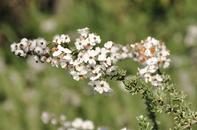This small shrub with silver leaves and white flowers are called Eriocephalus africanus and is of the Asteraceae family. Named after the fluffy seed tufts, the Cape Snowbush is also called kapokbos in Afrikaans or wild rosemary.

In southern Africa there are 34 species of Eriocephalus, all with these woolly fruits. Eriocephalus africanus (Cape Snowbush) is not be confused with Eriocephalus punctulatus or Cape chamomile.
It grows mainly in the Namaqualand, Western and Eastern Cape. The silver leaves help to reflect sunlight, to reduce leaf temperature and evaporation. This is one of the ways the plant adapts to preserve water when growing in arid conditions. Eriocephalus prefers full sun and well-drained soils.
Benefits of Cape Snowbush
Traditional uses by the Khoi and early Cape settlers included treating stomach ailments, as a mood enhancer and as an relaxant. It was also thought to help with hair growth, breaking addictions and letting go of negative emotions. Similar to rosemary, Cape Snowbush has an invigorating effect and acts as an antidepressant, also relieving feelings of stress, anxiety and anger.
Cape Snowbush oil relieves spasms (muscle, respiratory, digestive) and is effective to stop bleeding. Its antiseptic and antiviral properties protect the body against infections. It is also used as a diuretic (to expel toxins from the body), treats coughs and colds and soothes headaches. Rubbing the leaves, the plant gives off a fresh camphor smell.
Medical Disclaimer
Information is for educational and informational purposes only and may not be construed as medical advice. The information is not intended to replace medical advice or treatment offered by healthcare professionals.
By Marinda Louw
For bulk or Cape Snowbush export enquiries please use the enquiry link below.